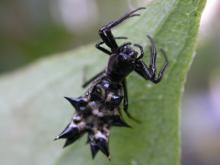Land Invertebrates
Media

Species Types
Scientific Name
About 6,500 species have been named so far, worldwide.
Description
Daddy longlegs, or harvestmen, are familiar Missouri animals. They are not spiders, but opilionids. Unlike spiders, they have a fused body form and lack silk and venom glands.
Media

Species Types
Scientific Name
Neriene radiata (formerly Prolinyphia marginata)
Description
The filmy dome spider is one of the most abundant woodland spiders in Missouri. Although the spider is tiny, its snare web, which looks like an upside-down silk bowl, is conspicuous throughout the year.
Media

Species Types
Scientific Name
Micrathena gracilis
Description
The color pattern can vary, but the ten-spined, chunky abdomen sets the female spined micrathena apart from all other spiders.
See Also



Media

Species Types
Scientific Name
Cisseps fulvicollis
Description
The yellow-collared scape moth is more often “orange-collared.” And whether you think it looks more like a firefly or a wasp, it’s still a moth!
Media

Species Types
Scientific Name
Nearly 150 species in North America north of Mexico
Description
Slim, delicate plume moths are instantly recognizable by their T-shaped silhouette, long legs, and muted shades of tan and brown. It can be hard to separate the various species.
Media

Species Types
Scientific Name
Pyrrharctia isabella
Description
Not many people know the adult Isabella tiger moth when they see one, but we’re all acquainted with its caterpillar, the woolly worm, or woolly bear.
About Land Invertebrates in Missouri
Invertebrates are animals without backbones, including earthworms, slugs, snails, and arthropods. Arthropods—invertebrates with “jointed legs” — are a group of invertebrates that includes crayfish, shrimp, millipedes, centipedes, mites, spiders, and insects. There may be as many as 10 million species of insects alive on earth today, and they probably constitute more than 90 percent all animal species.





















